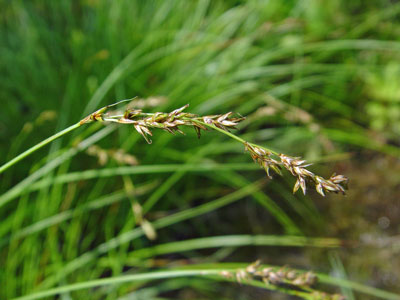DACF Home → Bureaus & Programs → Maine Natural Areas Program → Communities, Plants, and Animals → Rare Plants → Carex prairea
Carex prairea Dewey ex Wood

Prairie Sedge
- State Rank: S1
- Global Rank: G5
- State Status: Threatened
Habitat: Circumneutral fens, meadows, and wet thickets. [Open wetland, not coastal nor rivershore (non-forested, wetland)]
Range: Quebec to Alberta, south to New Jersey, and west to Nebraska.
Aids to Identification: Identification of species of the genus Carex is usually difficult and dependent upon rather technical characters. C. prairea is in the section Paniculateae and it is distinguished by the combination of the following characteristics: leaves are 1-3 mm wide; perigynia are ovate, tapering to a beak, and covered with scales; the vein-less band of the leaf sheath is yellow-brown. The lower nodes of the inflorescence bear 2 or more spikes and the sheaths lack red dots that are present in C. diandra.
Ecological characteristics: In Maine this sedge is known to occur in circumneutral fen communities.
Phenology: Fruits late May - July.
Family: Cyperaceae
Synonyms: Carex diandra Schrank var. ramosa (Boott) Fern.
Known Distribution in Maine: This rare plant has been documented from a total of 6 town(s) in the following county(ies): Aroostook.
Reason(s) for rarity: Scarcity of suitable habitat.
Conservation considerations: Because this sedge is typically found in the more open areas of cedar fens, it is likely that partial or patchy removal of the canopy would maintain suitable habitat for this species. Full removal of the canopy would be likely to lead to more drastic habitat changes that could adversely affect the plant.